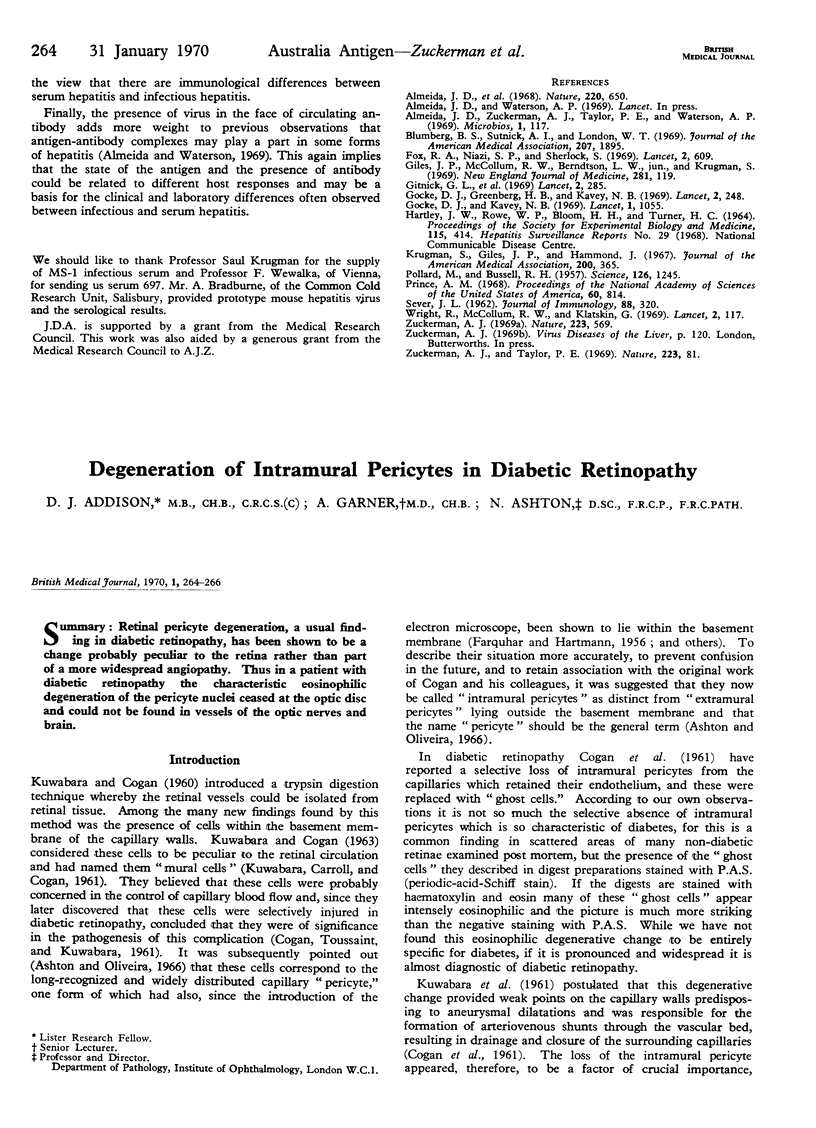Abstract
Examination of serum specimens from a patient with chronic active hepatitis proved negative to the Australia-SH antigen by immunodiffusion and by complement fixation. Because the sera were anticomplementary they were examined with the electron microscope, and virus-like structures similar to members of the coronavirus group were identified. The possible significance of this finding in human serum and its relation to mouse hepatitis virus are discussed.
A sample of the serum pool containing the MS-1 agent was found negative when examined by immunodiffusion, complement fixation, and electron microscopy. The possible lack of immunological identity between infectious and serum hepatitis is discussed.
Full text
PDF


Images in this article
Selected References
These references are in PubMed. This may not be the complete list of references from this article.
- Blumberg B. S., Sutnick A. I., London W. T. Australia antigen and hepatitis. JAMA. 1969 Mar 10;207(10):1895–1896. [PubMed] [Google Scholar]
- Fox R. A., Niazi S. P., Sherlock S. Hepatitis-associated antigen in chronic liver disease. Lancet. 1969 Sep 20;2(7621):609–612. doi: 10.1016/s0140-6736(69)90324-9. [DOI] [PubMed] [Google Scholar]
- Giles J. P., McCollum R. W., Berndtson L. W., Jr, Krugman S. Relation of Australia-SH antigen to the willowbrook MS-2 strain. N Engl J Med. 1969 Jul 17;281(3):119–122. doi: 10.1056/NEJM196907172810302. [DOI] [PubMed] [Google Scholar]
- Gocke D. J., Greenberg H. B., Kavey N. B. Hepatitis antigen. Detection of infectious blood donors. Lancet. 1969 Aug 2;2(7614):248–249. doi: 10.1016/s0140-6736(69)90011-7. [DOI] [PubMed] [Google Scholar]
- Gocke D. J., Kavey N. B. Hepatitis antigen. Correlation with disease and infectivity of blood-donors. Lancet. 1969 May 31;1(7605):1055–1059. doi: 10.1016/s0140-6736(69)91701-2. [DOI] [PubMed] [Google Scholar]
- Krugman S., Giles J. P., Hammond J. Infectious hepatitis. Evidence for two distinctive clinical, epidemiological, and immunological types of infection. JAMA. 1967 May 1;200(5):365–373. doi: 10.1001/jama.200.5.365. [DOI] [PubMed] [Google Scholar]
- POLLARD M., BUSSELL R. H. Complement fixation with mouse hepatitis virus. Science. 1957 Dec 13;126(3285):1245–1246. doi: 10.1126/science.126.3285.1245. [DOI] [PubMed] [Google Scholar]
- Prince A. M. An antigen detected in the blood during the incubation period of serum hepatitis. Proc Natl Acad Sci U S A. 1968 Jul;60(3):814–821. doi: 10.1073/pnas.60.3.814. [DOI] [PMC free article] [PubMed] [Google Scholar]
- SEVER J. L. Application of a microtechnique to viral serological investigations. J Immunol. 1962 Mar;88:320–329. [PubMed] [Google Scholar]
- Wright R., McCollum R. W., Klatskin G. Australia antigen in acute and chronic liver disease. Lancet. 1969 Jul 19;2(7612):117–121. doi: 10.1016/s0140-6736(69)92437-4. [DOI] [PubMed] [Google Scholar]
- Zuckerman A. J., Taylor P. E. Persistence of the serum hepatitis (SH-Australia) antigen for many years. Nature. 1969 Jul 5;223(5201):81–82. doi: 10.1038/223081a0. [DOI] [PubMed] [Google Scholar]
- Zuckerman A. J. Viral hepatitis and the Australia-SH antigen. Nature. 1969 Aug 9;223(5206):569–572. doi: 10.1038/223569a0. [DOI] [PubMed] [Google Scholar]








